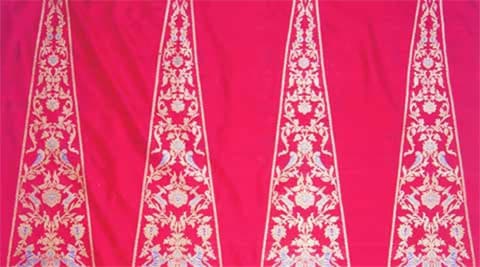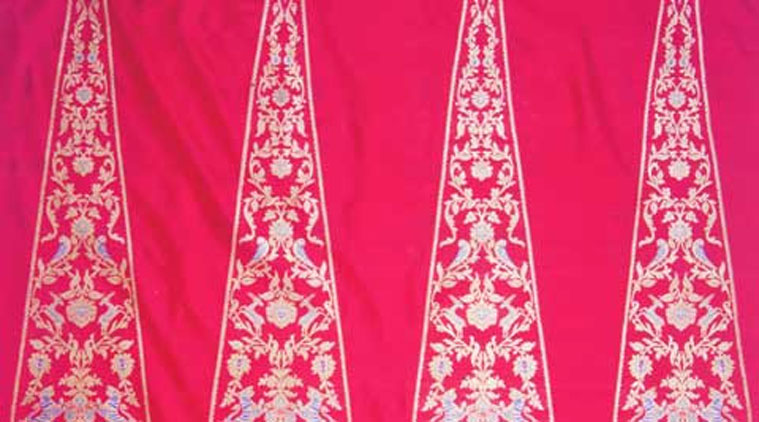Opinion ‘Handloom act is impractical unless it is properly implemented’
The Handlooms (Reservation of Articles for Production) Act, 1985, is impractical unless it is properly implemented.
 Smriti Irani, Smriti Irani textiles, Textiles Ministry, Smriti Irani HRD, Smriti Irani ministry, modi cabinet, modi cabinet reshuffle
Smriti Irani, Smriti Irani textiles, Textiles Ministry, Smriti Irani HRD, Smriti Irani ministry, modi cabinet, modi cabinet reshuffle  There should be no distinction between a sari and your everyday clothes. Why should the sari be regarded as a different garment?
There should be no distinction between a sari and your everyday clothes. Why should the sari be regarded as a different garment?
With his label Raw Mango, designer SANJAY GARG has been at the forefront of the movement to contemporise handwoven saris. He spoke to Yamini Lohia about the revival of handloom, and weighed in on whether powerloom is an existential threat to handloom:
Q: What are your thoughts on the handloom versus powerloom battle?
It’s okay to love handloom, I love handloom too. But why does that have to mean you hate powerloom? I don’t understand that face-off. You can create something beautiful and unique out of the hand, but you can also create something lovely from a machine. I don’t think we can remove machines from our day to day life. Other essentials come from machines, like our cars, computers and mobiles. There we want updated technology. Then how are we suddenly so anti-machine when it comes to this?
The Handlooms (Reservation of Articles for Production) Act, 1985, is impractical if it is not properly implemented. We’ll keep the law, but it’s not like we know how to follow it. Other than saris, protected items include towels, mekhala chaddar, durri, loi, dhotis, etc. But how many cases have there been of actually prosecuting violations? Should we be making laws without following them and which nobody wants to implement? It’s more important to create awareness around it.
There are also laws and directives in India where government uniforms and the national flag are to be made by handloom material, but how often does that happen? The government and its agencies violate their own orders. There is a great gap between intent and implementation.
Q: The concern was that if you take out saris from the handloom act, it would just kill the handloom industry because saris are by far the most visible and popular product. How do you propose addressing that?
Jo ban chuka hai usme apne kya bacha liya? The more important work is left. How does a customer know to distinguish between handloom and powerloom? Creating noise around this supposed denotification is not helpful; it is just massaging our egos. The real question is how do we create awareness around handloom? How do we differentiate between handloom and powerloom? How do we do this in school, in the education system of our country?
Q: What are your thoughts on the current sari revival movement?
You revive the sari, then tomorrow it dies again. Maybe it’s not a great design — I know people will attack me for saying that — but many fabrics don’t drape very well, you can’t wash it in the washing machine, they bleed, they can’t be put out in the sun, a worker can’t afford it. That’s where machines come in, to address those gaps. It’s not the enemy, it’s just balancing the act so everyone can still wear saris. If it was just handloom, we’d also turn into Colombo where everyone wears a skirt and blouse. I’m all for handloom but I don’t want sympathy around it. So when you say it’s India’s pride and culture, I understand that, but for me it doesn’t work for a longer period because you’ve created this pity and that’s why people buy, to “save the culture”, but if it’s not practical people won’t wear it, you’ll just fold it and keep it in a cupboard. Real revival would be to come up with changes according to the times, suited to the lifestyle, the way we did at Raw Mango.
Q: How did you popularise handloom saris among contemporary women?
At Raw Mango, we worked on the drape of the sari. People who traditionally wore handloom saris went away not because they didn’t want to wear handloom but because they needed fabrics that would drape well. And we see they’re coming back now. We also introduced a new colour palette and different kinds of zaris. In terms of design, we simplified the sari layout, reduced the visual clutter and introduced a new vocabulary of motifs. Then, of course, there is the quality of our product. And we created awareness about its history and uniqueness.
There should be no distinction between a sari and your everyday clothes. Why should the sari be regarded as a different garment? When you label one as traditional and the other as modern, that whole classification is wrong to me. When you come in a t-shirt and jeans, I don’t notice you. The minute you come in a sari, I start noticing you, why? Why does the sari have this baggage? I think it’s created by the media, in part, and especially in cosmopolitan cities. The day the sari becomes like any normal garment, it won’t have to deal with the threat of reviving or surviving.
I don’t think the noise around the loom or the sari does anything. Reservation has been around for so long, but then if it was working, why did it die in the first place? How did it get to this stage if the law was working?
Q: Handloom is more expensive. Why?
Privileging handloom is elitist. So many NGOs work on the ground in India, in handloom otherwise, how many of their children become weavers? They are always trying to weaver’s children to become weavers. But why won’t they encourage their kids to do it? Isn’t it casteist, in a way? Only a weaver’s son should be a weaver? Why can’t my kid become a weaver? Handloom is becoming a luxury product, as it should be. How can you expect to earn less than Rs 500 a day? I respect the idea that the sari should be cheap so more people can wear it. But, for example, if it takes five days, the weaver must earn Rs 2500 per sari.
Q: So you think a “save the handloom culture” sort of campaign is counterproductive?
Yes. Until young blood comes in, in terms of designers, textile engineers, you can’t innovate. Handloom is not a sustainable business and until it becomes one, it will need constant rescue. It has go beyond the sentiment that “yeh NGO waalon ka kaam hai”. You don’t have success stories coming out of handloom, so how will it attract new talent? You have to have role models and you have to demonstrate that it is profitable to be a weaver, as much as to be a designer. You can’t have entrepreneurship otherwise.
I also don’t know how many people know that in Varanasi, for instance, most weavers work on handloom and powerloom both. We empathise with the weavers when they work on handloom but our perspective changes when the same people work on the machine.
Q: Is there a way in which the government can help this process?
I come from a lower middle class background and I’ve reached here on my own. But I’m still much better off than most people in this country. Hum logon ki kya contribution hai to making our country? One option is to fight for it and do it myself, and second is to wait for the government to come and help me out. I don’t believe in the latter. We are fortunate, and I certainly don’t think we as designers need funds. It should be given directly to the weaver. Some NGOs work well, likes Dastkar, Dastkari Haat Samiti and Crafts Council of India, and if all NGOs were like that it would be great. But most aren’t. More than the social sector we need entrepreneurship.
Q: How can the government protect weavers?
First, the quality of the yarn material, the government could do something on that. It should spend money on design development and innovation, and training the weaver regarding quality and skills upliftment. Most importantly, it needs to commit 365 days of business to him. I would rather the government spent money on creating brand awareness about the varieties and types of weaves we have. We have no awareness about textile design, typology and history in our schools. In Indonesia, they have two kinds of textiles, ikat and batik, and these were written about in textbooks and tourist books. But in India there is no mention of textiles, though we have so many. We need to start celebrating that.
Q: How is the designer-weaver relationship is structured?
I don’t have a factory, everything is produced in weavers’ houses. You give them a commitment that you will give them 365 days of business and then they’ll work exclusively for you. That number for me has risen from 4 to 450 today. This is also why what FabIndia and Anokhi have done is so good — they develop good designs and give business to artisans. Ethical business practices are all you need, you don’t need a sad story to sell. You need people to buy handloom just because it is a good product and offers something better or more distinctive than a machine.
The underpaid weaver is a personal motivation and my love for handloom inspires me to work. But not to sell — that is on the design, innovation and the quality of the product.





